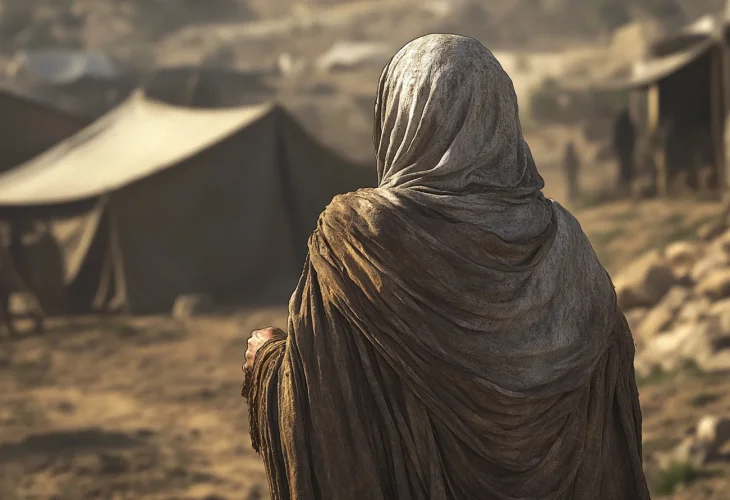Issues in the Bible
The Hidden Meaning of Biblical Leprosy: What Tzara’at Reveals About Divine Touch and Human Transformation
How the Torah’s mysterious laws of tzara’at unveil a deeper message about spiritual healing, divine connection, and the restoration of human essence

The Torah devotes an unusually long section to the laws of tzara’at — the strange condition often translated as “leprosy.” Rabbi Samson Raphael Hirsch points out that only three sections in the entire Torah begin with the phrase “When a person…” (Adam ki…): the laws of offerings, the laws of tzara’at, and the laws of impurity from contact with the dead.
According to Hirsch, this is because all three deal with the restoration of human essence after it has been disrupted. The purification from contact with the dead repairs a person’s connection to life; the offering replaces the sinner’s own death — symbolically dying in his stead; and tzara’at, too, represents a kind of death, for the afflicted person is considered “as one dead.”
Why the Leper Was Considered “Like the Dead”
When King Uziyahu of Yehuda was struck with tzara’at, he was sent to live in what the Sages called the “house of freedom” — which they interpreted as a dwelling in a cemetery. Why a cemetery? Because the metzora (leper) was regarded as a living corpse.
The Torah describes the dead as being “free” from obligation — “among the dead he is free”, and likewise, the metzora was “freed” from many commandments. He was cut off not only from any ritual requiring purity but also from society, community, family, and property. Most of the mitzvot were inaccessible to him. He was physically alive but spiritually and socially dead.
Even the mourning customs applied to him: he covered his face like a mourner (“he shall cover his mustache,” which the Aramaic translation renders, “he shall wrap himself like one in mourning”). When Miriam the prophetess became leprous, Moses pleaded, “Please do not let her be as one dead.”
Iyov (Job), who was struck with sores by Satan, was not afflicted with tzara’at — only with boils, because if he had become a metzora, he would truly have been “as dead,” unable even to speak with his friends, who would have had to keep their distance.
The Meaning of “Nega” — A Divine Touch
The Hebrew word “nega” (plague or affliction) does not mean leprosy by definition. The “great plagues” that struck Pharaoh in Bereishit were not tzara’at, but rather signs that the hand of God had touched him.
Thus, the metzora is one whom God has touched to separate — a spiritual quarantine by divine decree.
This explains an important halachic principle: a doubtful case of leprosy is initially considered pure. Why? Because the nega is a heavenly message, and Heaven does not “stammer.” If God intended to exclude someone, He would make the sign clear. An uncertain mark is only a warning. Once the person has been declared impure, however, any further doubt is treated like any other prohibition.
The Miracle of Moshe's Hand
This concept helps explain one of the signs shown to Moshe: when he placed his hand inside his cloak, it became leprous, and when he withdrew it again, it was healed. This was not a random wonder, but a demonstration that “the hand of God” could both strike and heal.
The hand itself symbolizes divine agency and mission — the “extended hand” of the One who sends. Moshe was being shown that as God’s messenger, he could transmit both plagues and healing in accordance with the divine will.
A Privilege of the Chosen Nation
The laws of tzara’at were given only to Israel. A gentile with a similar condition is not rendered impure, because only those who live in closeness to God are subject to the “touch of His hand.”
Even Moshe himself was momentarily stricken — the Sages teach that this occurred because he spoke ill of the people of Israel. Of course, at his exalted spiritual level, even the slightest misjudgment warranted divine rebuke.
Likewise, King Uziyahu was punished with tzara’at for offering incense without permission — a transgression made grave precisely because of his elevated status. This was not mere punishment but a mark of distinction: because he was a descendant of the royal house of David, his sins merited divine response in this world. Lesser individuals might sin without any such visible sign at all.
The Radiance of Divine Contact
Curiously, the Torah describes tzara’at as “bright” or “shining.” In King Uziyahu's case, it was said to have “flashed forth upon his forehead.” This brightness symbolizes the light of divine contact.
When the tzara’at appears where hair has fallen away, the smooth skin gleams — the same root meaning as “polished gold” (memurat), suggesting the same kind of radiance.
When God’s hand touched Moshe in blessing rather than judgment, “the skin of his face shone” so powerfully that others could not gaze upon him, and he had to veil himself.
Similarly, when the angel struck Yaakov, “he touched the hollow of his thigh” — not with violence but with a single touch that dislocated it. A divine touch, whether to bless or to wound, carries overwhelming power.
Healing Comes Through Moral Repair
Because tzara’at represents a direct touch of the Creator, it cannot be treated medically. The Torah never prescribes ointments or medicines. Instead, the only path to healing lies in moral and spiritual correction.
The affliction is not a disease of the body but a mirror of the soul — a visible message from Heaven that something within must change. When the person corrects that inner fault, the divine light that once struck him returns to heal.

